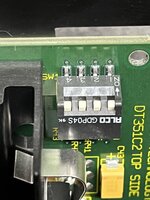ObeyDaleks
Well-known member
Hey folks,
I recently grabbed a MAXPower G3 500Mhz card for my MP 8500 to replace my 400Mhz Sonnet (cuz why not? ). The issue I'm facing is that when I drag windows around etc, they leave little outlines and dots around. The menu bars also have some color distortion that gets worse any time I move the windows.
). The issue I'm facing is that when I drag windows around etc, they leave little outlines and dots around. The menu bars also have some color distortion that gets worse any time I move the windows.
This only happens with the onboard video, it's totally fine with the Radeon 7000. When I switch back to the Crescendo, the onboard video works fine. There are no other issues with the NewerTech card, it is rock solid.
Any idea what the issue can be? One theory I have is that maybe the original VRAM is not fast enough for the new CPU? But I couldn't find any other threads describing anything similar.
P.S. The board is recapped btw.
I recently grabbed a MAXPower G3 500Mhz card for my MP 8500 to replace my 400Mhz Sonnet (cuz why not?
This only happens with the onboard video, it's totally fine with the Radeon 7000. When I switch back to the Crescendo, the onboard video works fine. There are no other issues with the NewerTech card, it is rock solid.
Any idea what the issue can be? One theory I have is that maybe the original VRAM is not fast enough for the new CPU? But I couldn't find any other threads describing anything similar.
P.S. The board is recapped btw.

